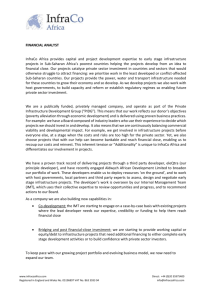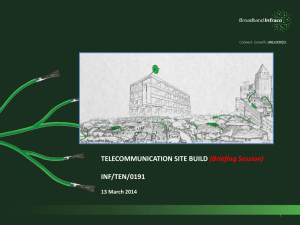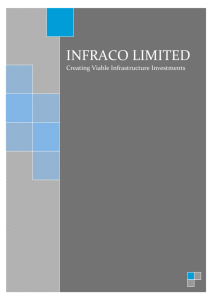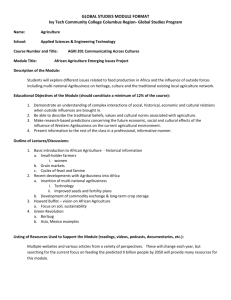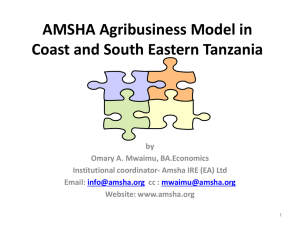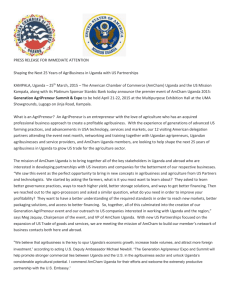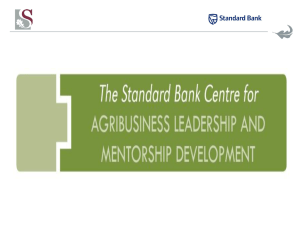Supporting Infrastructure Investment in Developing
advertisement
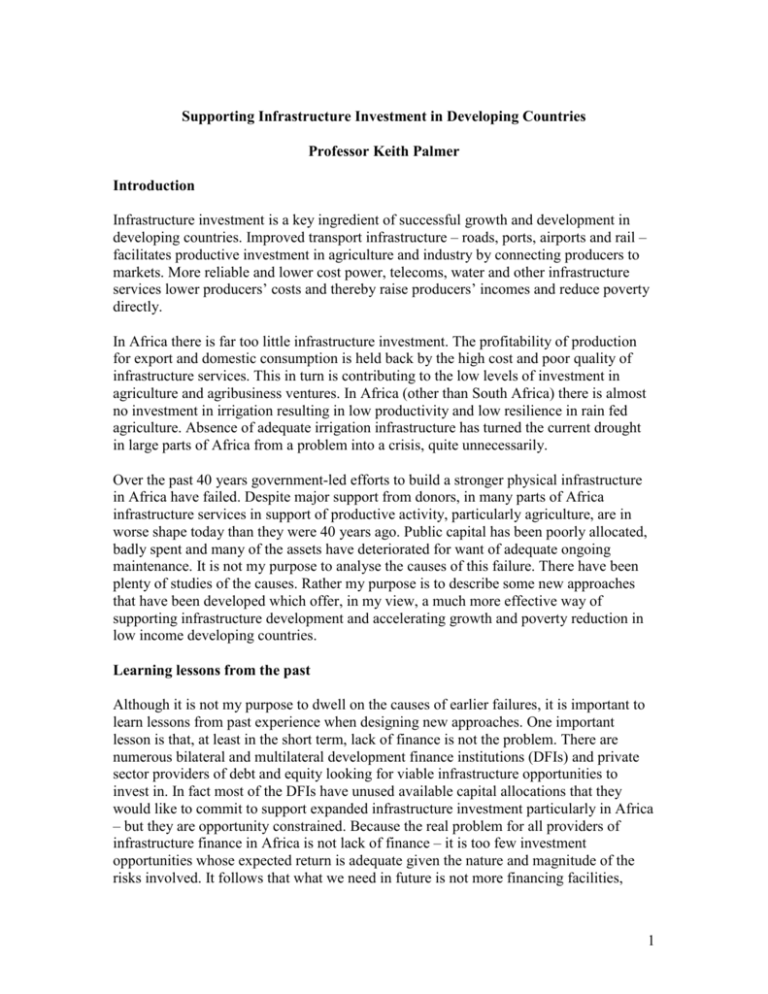
Supporting Infrastructure Investment in Developing Countries Professor Keith Palmer Introduction Infrastructure investment is a key ingredient of successful growth and development in developing countries. Improved transport infrastructure – roads, ports, airports and rail – facilitates productive investment in agriculture and industry by connecting producers to markets. More reliable and lower cost power, telecoms, water and other infrastructure services lower producers’ costs and thereby raise producers’ incomes and reduce poverty directly. In Africa there is far too little infrastructure investment. The profitability of production for export and domestic consumption is held back by the high cost and poor quality of infrastructure services. This in turn is contributing to the low levels of investment in agriculture and agribusiness ventures. In Africa (other than South Africa) there is almost no investment in irrigation resulting in low productivity and low resilience in rain fed agriculture. Absence of adequate irrigation infrastructure has turned the current drought in large parts of Africa from a problem into a crisis, quite unnecessarily. Over the past 40 years government-led efforts to build a stronger physical infrastructure in Africa have failed. Despite major support from donors, in many parts of Africa infrastructure services in support of productive activity, particularly agriculture, are in worse shape today than they were 40 years ago. Public capital has been poorly allocated, badly spent and many of the assets have deteriorated for want of adequate ongoing maintenance. It is not my purpose to analyse the causes of this failure. There have been plenty of studies of the causes. Rather my purpose is to describe some new approaches that have been developed which offer, in my view, a much more effective way of supporting infrastructure development and accelerating growth and poverty reduction in low income developing countries. Learning lessons from the past Although it is not my purpose to dwell on the causes of earlier failures, it is important to learn lessons from past experience when designing new approaches. One important lesson is that, at least in the short term, lack of finance is not the problem. There are numerous bilateral and multilateral development finance institutions (DFIs) and private sector providers of debt and equity looking for viable infrastructure opportunities to invest in. In fact most of the DFIs have unused available capital allocations that they would like to commit to support expanded infrastructure investment particularly in Africa – but they are opportunity constrained. Because the real problem for all providers of infrastructure finance in Africa is not lack of finance – it is too few investment opportunities whose expected return is adequate given the nature and magnitude of the risks involved. It follows that what we need in future is not more financing facilities, 1 rather it is more mechanisms to manage and reduce the risks and improve the expected returns offered by infrastructure investments. Another important lesson is the need to distinguish between economic benefits and financial returns. Investments in roads (other than toll roads) rarely generate a direct revenue stream that can be used to pay the cost of the capital invested in building and maintaining them. But the indirect benefits in terms of induced higher incomes for users eg in agriculture that accrue over the life of the assets can easily justify the costs of investment. Water and sanitation projects, including irrigation services, often have major economic, social and health benefits for users but the full costs of provision of the new services will usually be unaffordable for very poor people. Ultimately growth of incomes and tax revenues will generate additional resources to pay for the infrastructure but in the short term the direct project revenues will be insufficient to pay the costs of capital. The lesson to be learned is that we need mechanisms to facilitate investment in infrastructure with high socio-economic net benefits even if the financial returns captured by the project entity in the short term are not sufficient to pay the cost of capital. But these mechanisms must create sustainable futures, so that any financial subsidy, when it is phased out, leaves communities with sustainable infrastructure services. There are four key problem areas that have plagued infrastructure investment in the past in many low income developing countries and which the new initiatives that I describe below are designed to address. Co-ordination problems the inter-dependency of investments along long supply chains causes real problems for investors in each segment of the chain. Figure 1 illustrates the problem in agriculture. Profitable investment in agricultural production requires complementary investments in irrigation, electricity supply, improved roads, storage facilities and export terminals. If each link in the production-supply chain is successfully delivered on time then all links are predicted to be profitable. However if just one link fails then investment in each of the links will fail. This inter-dependency of investments undertaken by different parties substantially increases non-controllable investment risk. It deters investment in all the links in the supply chain. The risks are exacerbated when the rights to build and operate infrastructure are held exclusively by any one party including monopoly State-owned utilities. Front-end costs and risks most infrastructure investments require a considerable amount of time and managerial commitment to pre-development activities before major investments can be financed. Many infrastructure services are regulated and/or sell their output to a State utility. Before financing can be arranged agreements with governments, regulators and State utilities must be signed. Figure 2 shows schematically some of the steps that must be completed before a corporate investor can secure financing, in this case for a power project. ‘Frontend’ project development activities during this ‘pre-financial close’ period are subject to very high risk for several reasons. First, because of the interdependency problem noted above. The timing for reaching financial close on the 2 infrastructure investment is often hostage to parallel developments in a number of complementary but separate investments. Second, because the investor is hostage to actions which the government and/or State utility may or may not take late in the pre-development process. Actions may include changing apparently agreed terms of agreements late in the negotiations but before signature or deciding not to sign agreements without which the investment cannot be financed or deciding not to grant assurances about the stability of agreed terms (without which the investment often cannot be financed). Such actions can render valueless the investors’ front-end investment. Because there are numerous examples of these sorts of actions having been taken in the past the risks of it happening again are perceived to be very high, and this raises the cost of capital and is a major deterrent to particularly front-end development activity by the private sector. Legacy issues poor macro-economic and sector policies in the past have left a legacy which affects behaviour by investors even if government policies have subsequently improved. That legacy includes the perception of high political and regulatory risks in many developing countries. This perception: (i) deters corporate investment because companies fear a change in the ‘rules of the game’ after capital has been sunk; (ii) raises the cost of finance and therefore the charges that users must bear, often to levels that are unaffordable; and (iii) shortens the tenor of loans that lenders are willing to make, when what is needed in infrastructure and agriculture is long term finance. Another legacy of poor macroeconomic policies in the past is often high local currency real interest rates which discourage borrowing in local currency and cause investors to choose to finance in foreign currency, thereby increasing exchange rate risks borne by investors and ultimately by users. Incentives and sustainability when anything is free people want as much of it as they can get. There is no rationing according to the value to the recipient. In the past a lot of development assistance was provided in the form of grants or loans which it was not really expected would need to be repaid. One entirely predictable result is that the allocation of resources was not made according to the value attributed to the resource by the beneficiary, and a great deal of the development finance proved to be unproductive and was wasted. A second equally predictable result is that grant supported activities often turned out to be unsustainable – as soon as the grant support ended the activity degraded because there was no longer the money to sustain it. Many grand infrastructure projects built over the past several decades have suffered this fate. The third entirely predictable result was corruption. Those with the power to hand out money that does not have to be repaid will always be subject to the temptation to allocate it according to who makes it most worth their while. The distortions induced by provision of grant funding need to be addressed taking account of the affordability issues noted above. 3 Figure 1: Agribusiness Value Chain Focus Areas • Agriculture specific infrastructure: storage, irrigation • General infrastructure: roads, ports, power and telecoms Large scale production (crops, livestock, fisheries) Technology development Production of inputs Extension & Distribution businesses Processing and value add activities Logistics, wholesale and exporting Final demand for product Small scale production (crops, livestock, fisheries) Finance Supply / input delivery Demand / market linkages Figure 2: Infrastructure Project Development Early stage project development is a complex, protracted and risky process time Identify possible opportunities Pre-feasibility studies (markets, costs, regulation) Negotiate regulatory contract Negotiate input supply agreements Negotiate off take agreements (volumes, price) Negotiate contractual subsidies Secure rights to land, facilities, consents Negotiate local partnership agreements Commercial structuring to manage risks Full business and financial plan Arrange third party finance 4 Private Infrastructure Development Group The Private Infrastructure Development Group (PIDG) is a grouping of four European government development assistance ministries and the World Bank that have joined forces to develop new approaches to supporting infrastructure development in low income developing countries.1 Since its formation in 2001 the PIDG has overseen the creation of a number of innovative approaches to support for infrastructure investment in developing countries. Each of the PIDG initiatives has been designed to address one or more of the constraints on investment identified above. Here I describe three of them – Infraco, Guarantco and the Global Programme for Output Based Aid (GPOBA). Infraco Infraco provides a new approach to supporting infrastructure development in low income developing countries2. It has been designed to address directly the coordination problems and to mitigate the front end costs and risks of early stage development referred to earlier. Its purpose is to stimulate greater investment by the private sector alone and in partnership with national and/or local governments. Infraco offers a new approach in several ways: It is not an adviser – it acts as principal. It goes into countries and assembles the pieces of the investment jigsaw needed to attract investment from private sector investors and lenders. It is initially the owner or co-owner alongside national private investors of the rights to take forward the infrastructure investment. Activities undertaken by Infraco may include technical, environmental and marketing studies, negotiating project agreements with government, State utilities, contractors, suppliers and users, acquiring rights to use land and procuring financing from equity and debt providers. The management team are actively engaged in-country in progressing projects. Once the pieces of the jigsaw are assembled and it is possible to attract new corporate sponsors and third party development finance Infraco ‘sells’ some or all of its interest in the opportunity on to new entrants, both national and where appropriate foreign investors. Its role is never to displace the private sector, always to attract it. The sale of some or all of its interest in a project will realise the value created by its involvement. This value is reinvested in other project development opportunities. The Infraco management team is made up of private sector developers with extensive experience of this sort of development activity in developing countries. They know what they are doing. More important than that, they are remunerated on a success basis – they earn success fees for successfully attracting private 1 The PIDG members are the Netherlands, Sweden, Switzerland and the UK and the World Bank www.pidg.org 2 Further information about Infraco is available at www.infracolimited.com 5 investment and therefore they are subject to well-aligned financial incentives to deliver the mission and purpose of Infraco itself. There are special arrangements that require the team to progress a minimum number of what are called ‘High Development Value’ (HDV) projects which otherwise would be unlikely to feature in their development priorities. HDV projects include water and sanitation projects, small agriculture/agribusiness supporting infrastructure projects and other small projects with high perceived gain in reducing poverty. Special payment arrangements ensure that there are carrots as well as sticks to encourage HDV project developments. Infraco operates within policies set by the Board and approved by the shareholders. Key policies include: Infraco will only act in situations where the host country government strongly supports its involvement. Infraco prioritises opportunities that maximise its poverty reduction impact Infraco prioritises those opportunities where it believes that its involvement is most likely to catalyse new investment and lending by the private sector. Infraco is trying to be innovative, to ‘think outside the box’ about the ways to cost effectively improve infrastructure in its target countries. Some of the innovative thinking that it is deploying is set out in Figure 3. It works in close collaboration with the other PIDG initiatives (especially Emerging Africa Infrastructure Fund, the PIDG-sponsored debt fund and Guarantco), with the other DFIs and remains in close contact with private sector developers. Infraco was established in 2005 with an initial capital of just $10 million subsequently increased to $20 million. In addition it has access to limited funds to support specific project activities from the PIDG. It has a co-operation agreement with the IFC and is progressing a similar agreement with the Asian Development Bank. Although Infraco has only been in existence for less that a year, there has already been remarkable progress. Initial visits to low income countries in Africa and Asia have revealed a lot of potential opportunities where Infraco can make a difference and where the host country governments are enthusiastic about Infraco participation. Over 60 projects were initially identified and after a thorough screening 14 were selected for the initial shortlist of high priority projects, within 6 months of start-up. A brief description of the short-listed projects is set out in Figure 4. They include a broad range of types of infrastructure including 3 in water and sanitation and 3 in agriculture/agribusiness supporting infrastructure. If all 14 projects were to proceed the total additional induced investment would be close to $1000 million representing leverage of more than 50 times the PIDG investment in Infraco. Figure 5 describes briefly one of Infraco’s short-listed projects, the Kalangala project in Uganda. This is an integrated infrastructure services project where Infraco is putting in place a package of enhanced infrastructure services for the benefit of low income 6 smallholders. This is a classic situation where Infraco is addressing the co-ordination problems involved in provision of infrastructure services for small farmers as part of a much larger commercial agriculture/agribusiness venture. It is arranging the private sector provision and financing of infrastructure which the government has committed to provide, but which it would otherwise be unable to deliver or finance. Figure 6 summarises the key features of another short-listed project, the Kampala sewerage project. This is a partnership with the State-owned National Water and Sewerage Corporation to develop improved sewage collection and treatment facilities in Kampala. Infraco is working with the utility to develop a public-private partnership approach to developing the project. If successful it would be a valuable exemplar of how Infraco can work in partnership with a State utility to access private sector expertise and finance without prejudicing the commercial interests of the State utility or the national interest. 7 Figure 3: Examples of Infraco Innovation - Leveraging mining/oil and gas infrastructure Mining and oil companies often have quality dedicated infrastructure assets eg power Plants, roads and ports, housing, schools, health clinics etc Much of this infrastructure has redundancy built into it and there may be scope to make available surplus capacity to the local population at low marginal cost Infraco has identified a number of opportunities to leverage these assets eg in Ghana a foreign mining company has agreed to use its mine housing stock as platform assets to facilitate a major affordable housing development in the vicinity of the mine site, and in the Philippines the water assets developed for the mine will be used to supply water to an adjacent major town at low marginal cost. - Water and sewerage investments In this sector there are few situations where the concession approach to private finance is attractive either to governments or investors. Therefore new thinking is required. Infraco is working with State utilities to structure arrangements that will access private sector expertise and finance on terms acceptable to the host country and its water utility. Infraco is in advanced discussion in Uganda to implement such a scheme in Kampala. - Agribusiness infrastructure There is major unexploited agribusiness potential in Africa. Major constraints on investment include poor quality and high cost infrastructure, the scarcity of experienced commercial farming entrepreneurs, scarcity of aggregators to link smallholders to markets and supply them with seeds, fertiliser and other inputs and scarcity of credit (Technoserve 2004). There are success stories where these constraints have been overcome because actors have emerged to develop the logistics/supply chains, perform the role of aggregator and arrange for credit for small producers. However these successes are few and far between Infraco can and does address the infrastructure constraints by developing integrated Infrastructure services in support of agribusiness ventures. Examples in the short list include the Kalangala project in Uganda, the Manica irrigation and other infrastructure services project in Mozambique and several agribusiness supporting infrastructure projects under consideration in Zambia. - Low Carbon Energy Projects A number of new mechanisms have been put in place to enable developing countries to benefit from carbon abatement policies. European governments in particular are keen to support low carbon emitting technologies. So far there has been much talk and little action. There is scope for Infraco to play a lead role in low income developing countries in structuring and implementing low carbon emitting energy projects. 8 Figure 4: Summary of Infraco Shortlisted Projects Region Sector Description Development Impact Value of Investment East/South Africa Bidco, Uganda Agribusiness infrastructure Essential infrastructure to support major palm oil outgrowers scheme Substantial beneficial impact on livelihoods of poor farmers Manica, Mozambique Agribusiness infrastructure Irrigation dams to support growth of agriculture 5000 hectares of irrigated land in very poor part of country, major poverty reduction impact Infraco project c $10 million Maputo, Mozambique Agribusiness infrastructure Citrus fruit terminal expansion Expansion of agricultural export capacity in Maputo will allow rapid growth in export incomes c $20 million Kampala, Uganda Water & sewerage Construction of wastewater treatment plant in Kampala. Partnership with NWSC. Strong environmental benefits, Improved access c $30 million Kampala, Uganda Housing & related infrastructure Affordable housing in Kampala Helps address crisis in affordable accommodation c $6 million Volta Lake, Ghana Lake transport Strengthens transport infrastructure internally + from Ghana to Burkina Faso, Niger and Mali Major direct benefits for poorer communities in Ghana and indirect benefits (reduced transport costs) in landlocked countries c $10 million KumasiSunyani, Ghana Electricity transmission/ distribution Extension of electricity supplies to poorer communities currently not served Low cost access to electricity supply leveraging use of existing assets for mine c $27 million Kumasi, Ghana Housing & related infrastructure Low cost housing + related community services Low marginal cost access for local people leveraging mine infrastructure c $7 million (phase 1 only) 300MW gas fired power generation project using gas from Trans-W Africa pipeline Exploiting arrival of gas will reduce costs of energy for all consumers with direct and indirect benefits (stimulating new productive investment) $200 – 300 million Independent power project in Delta region Improving supply and reducing cost of power will stimulate more rapid growth Gathering and liquids extraction of flared gas Prevention of flaring of gas and provision of LPG to local market Total investment >$100m, Infrastructure >$20m West Africa Cenpower, Ghana Power Generation Aba, Nigeria Power Generation Gas project, Nigeria Gas distribution c $100 million tbd 9 Asia Hydro power Vinh Son, Vietnam 120 MW hydro power development Improving supply and reducing cost of power will support sustained rapid growth c $50 million 100mld water supply to Malubog leveraging assets developed for copper mine Improving access to water supply for City of Cebu at low marginal cost c $60 million 1st private sector water concession in Thailand Facilitate funding of major expansion of water services c $20 million (phase 1) Development of improved clean water supplies to Lusaka Request from government to consider arranging build, operate and financing of the investment $50-70 million Adaptation of existing freight rail line to provide improved access to low cost housing projects Request from government to consider developing this project that will benefit low income people primarily Irrrigation and related infrastructure development in Mkushi Infrastructure services company providing irrigation/other infrastructure to commercial and small farmers Improvement of sugar irrigation scheme to benefit commercial and small farmers Request to consider project development role working with small farmers groups and commercial farmers Water supply Malubog, Philippines Pathum Thani Thailand Central/ Southern Africa Zambia Zambia rail Zambia/ Mkushi Regional water supply Lusaka water/ Sewerage Lusaka low income light railway Infrastructure/ Farm block Infrastructure tbd tbd Zambia/sugar Irrigation/other infrastructure tbd 10 Figure 5: Kalangala Infrastructure Services Project In 2003 the Government of Uganda (GOU) agreed to provide infrastructure to support the development of an outgrower scheme around a major new domestic palm oil plantation and processing plant. The consortium (called Bidco Uganda Ltd) has already launched Phase I of the project consisting of the development of 10,000 hectares, 6500 hectares plantation and 3500 hectares outgrower scheme in partnership with smallholder farmers in Kalangala District on Bugala Island. Bidco has set up an edible oil refinery and soap plant in Jinja on the mainland to process the raw materials from the plantation. Although Bidco has proceeded with its project commitments, the GOU has not been able to provide the following promised infrastructure on Bugala Island. Electricity to Bugala Island where Bidco will build a processing plant. The electricity is needed during the construction period as the island is not connected to the grid. Thereafter, the processing plant will self-generate steam and electricity through cogeneration by burning some of the waste from the palm oil extraction process. Upgrade of 130 km of roads on the island. Although the roads exist they are poorly maintained and inadequate for the increased traffic that will result when production builds up. Ferry. There already exists a ferry between the island and the mainland, but again, once the Bugala Island plant is fully operational it will not be adequate. A new ferry or an upgrade to the existing ferry is required. InfraCo proposes to create a Ugandan infrastructure services company that will provide the necessary project development inputs to design and finance an appropriate solution for the provision of the above promised infrastructure elements. Developmental Impact This project will have a direct and substantial beneficial impact on the lives of poor farmers in an underdeveloped region of Uganda. The proposed infrastructure will allow the inhabitants of the island to have access for the first time to affordable and reliable electricity, adequate roads and enhanced ferry service to the mainland. This infrastructure will be necessary if the local farmers are to benefit fully from the outgrower scheme. The Kalangala Oil Palm project is part of the Ugandan Government’s Vegetable Oil Development Project (VODP) which is geared at increasing Vegetable oil production in Uganda and self-sufficiency. The Palm oil project itself is expected to create over 6,000 direct jobs, 15,000 indirect jobs and 3,000 farmers will benefit directly as out-growers. At peak production it is expected that incomes will be $1,450 per ha per year. Unused land will also be brought into economic activity. At full scale operation the plantation will produce 140,000 metric tones of palm kernel oil annually. 11 Figure 6: Kampala Sewerage Project InfraCo is in discussions with the national State-owned National Water and Sewerage Corporation (NWSC) of Uganda to develop a public-private partnership to develop and finance a sewerage treatment plant and collection system in Kampala. The proposed project would greatly improve the quality of the environment of the City and its residents – it would in particular improve the environmental conditions for the poor. NWSC is responsible for the provision of water and sanitation services in eighteen urban or periurban areas in Uganda, including Kampala. Despite the low levels of both water supply and sewerage coverage, NWSC is seen as a progressive utility with a well developed business culture and an effective management team. InfraCo is exploring the possibility of helping NWSC expand and effectively manage a wider network of waste water treatment plants in part of its service area using a private sector operator and raising private finance for the project development. Kampala has a rapidly growing population – currently 1.2 million but rising to over 2 million during the day. Water supply coverage in the area of the city is estimated at 60% but sewerage coverage is extremely low – estimated at only 6%, covering only the central part of the city. Tariffs for services are moving gradually towards commercially sustainable levels and NWSC’s operating revenues now cover operating costs but are insufficient to fund major capital improvement projects with commercial/DFI finance. NWSC is open to the involvement of the private sector in the management and delivery of services having awarded two management contracts in recent years to overseas operators for collection and operations assistance. NWSC is seeking to broaden its sources of funding for its own operations and hopes to tap the commercial banking market for corporate funding in the next five years. The proposed project would boost the coverage area for waste water services considerably from its current low levels.The majority of the population currently use either septic tanks or – for the majority – have no established method of sewage disposal, with resultant serious risks to the environment and public health. A large part of central Kampala is occupied by a new industrial area with no sewerage system and is currently generating high volumes of effluents that are discharged in an open environment with serious environmental consequences. The proposed €22 million project would expand the existing collection system and construct a new treatment plant to address urgent needs. The benefits of the project would therefore be substantial – enhancing the general health and livelihood of a wide sector of the populace. Capital investment by NWSC for new treatment plants or expansion of the system has to date been almost entirely grant funded with KfW being the major funding partner in recent years. InfraCo is discussing with the company the idea of accelerating the development of the project through a BOT or similar PPP3 structure including use of private finance. Initial discussions with KfW and the government indicate such an approach would be strongly supported. Infraco intends to explore an involvement which would centre on structuring a PPP vehicle and raising finance for such an approach. If successful it would provide a valuable exemplar of how Infraco can work in partnership with a national State owned water company to mobilise private sector expertise and funding without prejudicing the interests of the State utility or the national interest. It would also be a very interesting exemplar of a State utility graduating from 100% grant funding to a debt funded model, thereby freeing up scarce grant resources to pursue other development aims eg in education. 3 Public Private Partnership 12 Guarantco Guarantco has been created to support the mobilisation of domestic savings for infrastructure investment4. It offers credit enhancement for local currency debt provided by domestic banks and the domestic capital markets (where they exist). Key features of Guarantco include: It provides credit enhancement for debt issued by both private sector and municipal infrastructure investors. It aims to address failures in the supply of domestic savings for infrastructure in low income developing countries. Specifically it addresses market imperfections such as short tenors, single obligor limits, excessive collateral requirements and liquidity constraints. The guarantees cover default risk on the underlying debt service arising from commercial events. It provides partial risk cover - the risk must be shared with the borrower and/or lenders. Guarantee fees are charged at rates that reflect market conditions and perceived credit risks. In practice fees charged to high development value investments such as water and sewerage and agribusiness are lower than the full cost reflective charge. Guarantco operates in partnership with other development finance organisations offering comparable credit enhancement products including FMO (the Dutch DFI) and the IFC(with which it has a co-operation agreement). Guarantco is able to bid for technical assistance funds from PIDG to support the structuring of transactions. Guarantco’s capital comes from the PIDG in the form of paid-up share capital. The management of Guarantco is being outsourced to private sector credit professionals on terms that will align their incentives with the mission and purpose of Guarantco and its shareholders. Credit decisions are taken by the Board whose members have extensive private sector financial services and development finance expertise. Figure 7 summarises how Guarantco operates. It collaborates closely with the other PIDG initiatives and other DFIs and is in contact with the players in the domestic financial markets of the countries where the pipeline projects are located (including capital market regulators). Guarantco has completed one transaction to date, the guarantee of a local currency bond issued by a mobile telephone operator in Kenya. Other projects in the current pipeline include a gas distribution project financing in Tanzania, a solid waste treatment plant in Vietnam, water and sewerage projects in Kenya and Tanzania, an agribusiness infrastructure project in Zambia, low income housing finance in Ghana and Zambia and a hydropower project in Uganda. 4 Further information about Guarantco is available at www.pidg.org 13 Guarantco addresses some of the legacy issues referred to earlier. Local banks and domestic savings institutions tend to be highly risk averse, investing most of their funds in government securities. As a result it can be very difficult to fund infrastructure investment in local currency and such local currency debt as can be raised is typically short or medium term. Guarantco aims both to expand the pool of domestic savings available for investment in infrastructure and to increase the maturity of local currency debt issues. The availability of larger amounts of longer term local currency debt will reduce the exchange rate risks facing infrastructure investors and thereby lower the cost of capital. Figure 7 Basic structure PIDG Donors Others PIDG Trust Equity Contributions Equity or callable risk capacity GuarantCo Credit Guarantees Lenders/ Investors Project Company Projects 14 Global Programme of Output Based Aid GPOBA is a grant financing facility managed by the World Bank which is available to address the affordability of infrastructure for poor people5. It offers grant funding to finance targeted subsidies designed to mitigate the increase in costs of infrastructure for poor consumers that would arise following investment in improved infrastructure. Output based aid (OBA) will generally be structured such that the initial subsidy is phased-out gradually leaving a sustainable business once the subsidy has been withdrawn. OBA payments to the service provider are not made until the services are being provided to poor people and payments are conditional on the service provider having complied with pre-agreed service investment and performance targets. The subsidy per beneficiary is capped to ensure effective use of scarce grant finance. OBA is often required if rural infrastructure schemes are to provide affordable services to people who are very poor. OBA is being used in Infraco’s Kalangala project to make affordable the user charges for passenger traffic on the upgraded ferry connecting Bugala Island to the mainland. Can these approaches be adapted to support agriculture and agribusiness? Growth in agriculture and agribusiness are crucial if poverty is to be reduced in Africa. However investment in these sectors in Africa has been very depressed for decades. Many of the problems of inducing investment in agriculture and agribusiness are very similar to those that deter infrastructure investment. Co-ordination problems, legacy issues, long investment paybacks and limited availability and short tenor of finance are all prevalent in agriculture and agribusiness in Africa. Infraco has encountered numerous situations in Africa where growth in agriculture and agribusiness is being held back by these problems. Just as in infrastructure Infraco and Guarantco are making an important contribution to overcoming constraints on investment, in agriculture/agribusiness there are sound reasons to believe that similar sector-specific initiatives could make a comparable contribution. An agricultural Infraco could take on the front-end costs and risks of structuring the non-infrastructure aspects of agricultural and agribusiness projects. A Guarantco-type vehicle could be used to mobilise more credit from domestic financial institutions on better terms to finance growth of agriculture and agribusiness. These thoughts have been developed in much more detail in CEPA (2005) and Palmer (2004 a,b). Conclusions Infrastructure investment is a key ingredient of successful growth and development in developing countries. Improved infrastructure facilitates productive investment in agriculture and industry by connecting producers to markets. More reliable and lower cost infrastructure lowers producers’ costs and reduces poverty directly. 5 Further information about GPOBA is available at www.pidg.org 15 Over the past 40 years government-led efforts to build a stronger physical infrastructure in Africa have failed. Public capital has been poorly allocated, badly spent and many of the assets have deteriorated for want of adequate ongoing maintenance. As a result many governments in low income developing countries are showing renewed interest in accessing the expertise and finance available from the private sector to improve infrastructure services. The paper describes new initiatives sponsored by the PIDG to support infrastructure development and accelerate growth and poverty reduction in low income developing countries. Key lessons from past experience are: The cause of low investment in infrastructure is not lack of finance – it is lack of sufficient opportunities whose expected return is adequate given the nature and magnitude of the risks involved It is important to distinguish between economic benefits and financial returns. There are many infrastructure opportunities where the economic net benfits are high but the financial returns are low. There is a need for mechanisms to facilitate investment in infrastructure where there are high induced net economic benefits even if the financial returns in the early years are low. There are four key problem areas identified that deter infrastructure investment: Coordination problems. The interdependency of investments undertaken by different parties along supply chains substantially increases non-controllable investment risks for all parties. Front-end costs and risks. The risk that government and/or State utilities will change the rules of the game late in the process of securing financing increases non-controllable risks facing prospective investors and thereby deters investment and raises the cost of capital. Legacy issues. Poor past government policies raise the perception of high political and regulatory risks. This raises the cost of capital, reduces the availability of capital from domestic and foreign sources and shortens the period for which it is available. Distortions to incentives and lack of sustainability. In the past grant funding of infrastructure has distorted the allocation of resources and led to development of non-sustainable investments which have collapsed when the grant funding is exhausted. The PIDG has sponsored the development of several new approaches to supporting infrastructure investment in developing countries. The paper describes Infraco, Guarantco and GPOBA. Infraco has been designed to address directly the coordination problems and to mitigate the front end costs and risks of early stage development referred to above. Its purpose is 16 to stimulate greater investment by the private sector alone and in partnership with national and/or local governments. Guarantco has been created to support the mobilisation of domestic savings for infrastructure investment. It offers credit enhancement for local currency debt provided by domestic banks and the domestic capital markets (where they exist). Guarantco aims to expand the pool of domestic savings available for investment in infrastructure and to increase the maturity of local currency debt issues. The availability of larger amounts of longer term local currency debt will reduce the exchange rate risks facing infrastructure investors and thereby lower the cost of capital. GPOBA is a grant financing facility managed by the World Bank which is available to address the affordability of infrastructure for poor people6. It offers grant funding to finance targeted subsidies designed to mitigate the increase in costs of infrastructure for poor consumers that would arise following investment in improved infrastructure. Growth in agriculture and agribusiness are crucial if poverty is to be reduced in Africa. However investment in these sectors in Africa is being held back by many of the same problems that deter infrastructure investment. Co-ordination problems, legacy issues, long investment paybacks and limited availability and short tenor of finance are all prevalent. The paper argues for the adoption of initiatives in agriculture similar to those sponsored by PIDG in infrastructure. An agricultural Infraco could take on the front-end costs and risks of agricultural and agribusiness projects. A Guarantco-type vehicle could be used to mobilise more credit from domestic financial institutions to finance growth of agriculture and agribusiness by offering partial credit guarantees. References Artadi & Sala-i-Martin ‘The Economic Tragedy of the 20th Century: Growth in Africa’, National Bureau of Economic Research Working Paper 9865, 2003. Bouton & Sumlinski, ‘Trends in Private Investment in Developing Countries: Statistics for 1970-98’ Discussion Paper 21, International Finance Corporation, 2000. Cambridge Economic Policy Associates (CEPA), Overseas Development Institute (ODI) & Natural Resources Institute (NRI) ‘Supporting Pro-Poor Private Sector Rural Enterprise Scoping Study’ produced for Department for International Development UK, March 2002. CEPA ‘Mechanisms to Support Uptake and Use of Pro-Poor Agricultural Technologies’ produced for DFID, Nov 2002. CEPA ‘Justification and Possible Modus Operandi for Public Sector/Donor Support for Generation of Business Opportunities in Developing Countries’ produced for DFID, 2003. 6 Further information about GPOBA is available at www.pidg.org 17 CEPA ‘Agricultural Investment in Africa: An Overview’ (unpublished) for DFID, Jan 2005. Conway ‘The Doubly Green Revolution’ Penguin, 1997. DFID, ‘DFID & the Private Sector: Working with the private sector to eliminate poverty’, 2005. Fafchamps, Teal and Toye ‘A Growth Strategy for Africa’ produced for DFID, 2001. International Finance Corporation ‘Building the Private Sector in Africa: To Reduce Poverty and Improve People’s Lives’, 2000. International Finance Corporation ‘Trends in Private Investment in Developing Countries: Statistics for 1970-98’, 2000. International Finance Corporation ‘ Sub-Saharan Africa: Seeking Sustainable Economic Growth’, 2003. International Food Policy Research Institute ‘2020 Global Food Outlook’, 2001. International Monetary Fund ‘World Economic Outlook’, 2004. Page ‘Making Doha a Better Deal for Poor Countries’ Financial Times, 2004. Palmer ‘Promoting Private Investment in Developing Countries: Overcoming Market Failures’, 2003. Palmer ‘Achieving Higher Growth and Poverty Reduction in Sub-Saharan Africa: A note for the Commission for Africa’ (2004) Palmer ‘International Development Committee Inquiry on Private Sector Development: Submission from Professor Keith Palmer’ UK Parliamentary Committee (2006). Sanchez ‘Tropical Soils, Climate and Agriculture: an Ecological Divide?’ 2001. SIDA ‘Making Markets Work for the Poor’ 2003 Technoserve ‘Partnerships for Agribusiness Development, Agricultural Trade, and Market Access; A Concept Note for NEPAD’, Nov 2004. Tripp ‘Strengthening the Enabling Environment for Agricultural Technology Development’ ODI, 2002. UNCTAD ‘Economic Development in Africa: Performance, Prospects and Policy Issues’, 2001. UNIDO ‘Industrialisation, Environment and the Millennium Development Goals in SubSaharan Africa, 2004. 18 Wood & Mayer ‘Africa’s export structure in a comparative perspective’ Cambridge Journal of Economics, 2001. Wood ‘Could Africa be Like America?’ DFID 2002. World Bank, ‘Private Sector Development Strategy: Directions for the World Bank Group’ 2002. World Bank, ‘World Development Report 2004: Making Services Work for Poor People’ 2003. World Bank, World Development Indicators 2004. About the author Keith Palmer is non-executive Vice Chairman of Rothschild investment bank, Chairman of the Emerging Africa Infrastructure Fund and Infraco www.infracolimited.com , nonexecutive Director of Guarantco, Chairman of Cambridge Economic Policy Associates www.cepa.co.uk and part-time Professor at the Centre for Energy, Petroleum and Mining Law and Policy, University of Dundee. He previously worked for the World Bank, the IMF and as a contract civil servant in Papua New Guinea and Tanzania. Further details can be obtained at www.keithpalmer.org 19
